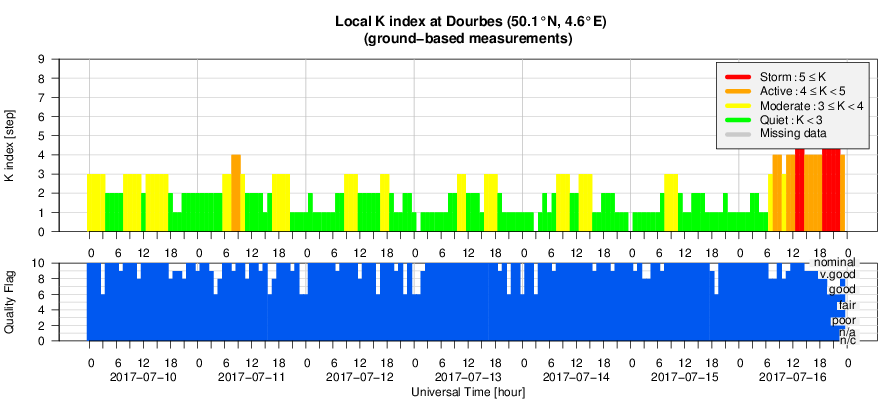- Table of Content
- 1.The Bastille D...
- 2.Review of sola...
- 3.Noticeable Sol...
- 4.PROBA2 Observa...
- 5.The Internatio...
- 6.Review of geom...
- 7.Geomagnetic Ob...
- 8.SIDC Space Wea...
- 9.Review of iono...
- 10.Future Events
2. Review of solar activity
3. Noticeable Solar Events (10 Jul 2017 - 16 Jul 2017)
4. PROBA2 Observations (10 Jul 2017 - 16 Jul 2017)
5. The International Sunspot Number
6. Review of geomagnetic activity
7. Geomagnetic Observations at Dourbes (10 Jul 2017 - 16 Jul 2017)
8. SIDC Space Weather Briefing
9. Review of ionospheric activity (10 Jul 2017 - 16 Jul 2017)
10. Future Events
The Bastille Day 2017 event
NOAA 2665 continued to dominate the solar surface and was also responsible for the main event of the week, i.e. a long duration M2 flare associated with a halo coronal mass ejection (CME) on the French National Day.
NOAA 2665 has been transiting the solar disk over the last two weeks, attaining its maximum size on 9 and 10 July before its trailing section started a gradual decay. Hence, its outlook changed considerably before it rounded the west solar limb on 17 July. Underneath SDO/HMI imagery (https://sdo.gsfc.nasa.gov/data/aiahmi/ ) of NOAA 2665 on 9 and 12 July.
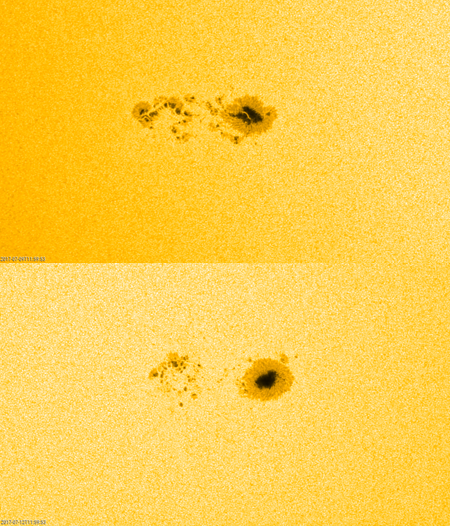
On 14 July, NOAA 2665 produced an M2.4 flare. It was a long duration event lasting no less than 2 hours and 17 minutes! The SDO images underneath show (on the left) the flare in extreme ultraviolet (EUV) of the AIA131 passband (multi-million degrees), whereas on the right it shows the event in the AIA193 passband at temperatures of about 1.3 million degrees). In particular the AIA193 images show the coronal dimming (indicative of the ejection of solar plasma) as well as some interaction with nearby NOAA 2666 very well.
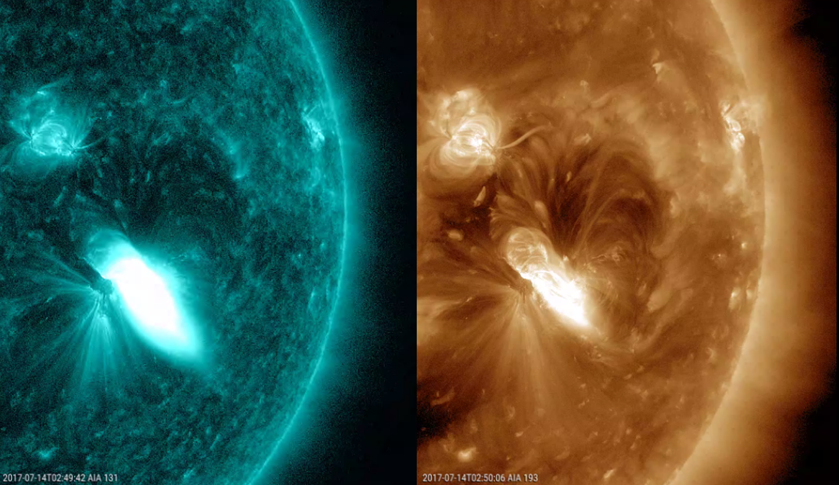
The M2 flare was also associated with a minor proton event, reaching 22 pfu (proton flux unit; see http://www.stce.be/news/233/welcome.html for more info) late on 14 July. It was the first proton event since 2 January 2016, which was of similar strength.
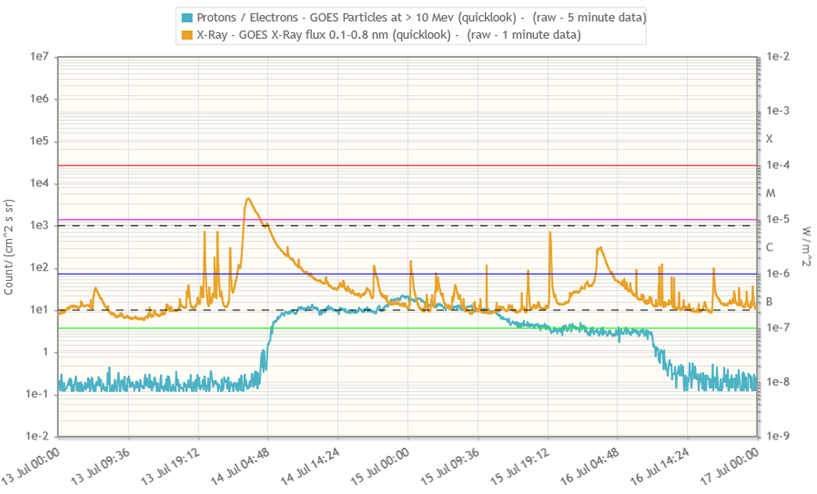
An asymmetric halo was observed by the SOHO/LASCO coronagraphs (https://sohowww.nascom.nasa.gov/ ), and first seen at 01:36UT. The true speed of the CME was estimated to be around 1200 km/s. Also the coronagraph onboard the STEREO-A spacecraft (https://stereo-ssc.nascom.nasa.gov/ ) recorded a full halo CME. As ST-A is currently about 45 degrees behind the solar east limb (as seen from Earth), and the flare's location was about 30 degrees west of the central meridian, the CME was on the solar backside as seen from ST-A.
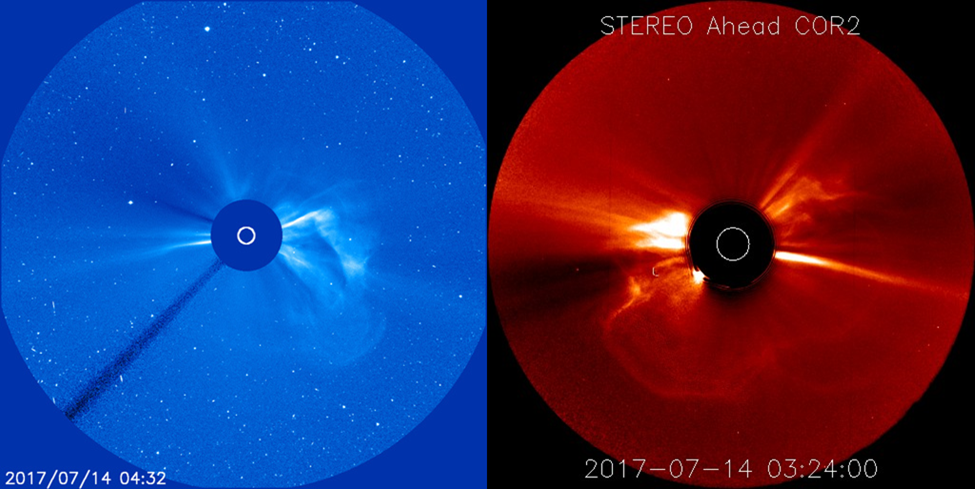
The name "Bastille Day 2017 event" is a wink to THE Bastille Day event back in 2000, when the CME associated with a strong X5 flare on 14 July (SOHO image underneath) caused an extremely severe geomagnetic storm late on 15 July. The International Space Station lost about 15 kilometers in altitude in just a few hours, and GPS inaccuracies doubled. Anno 2017, geomagnetic activity reached only moderate geomagnetic storming, with very limited technological impacts.
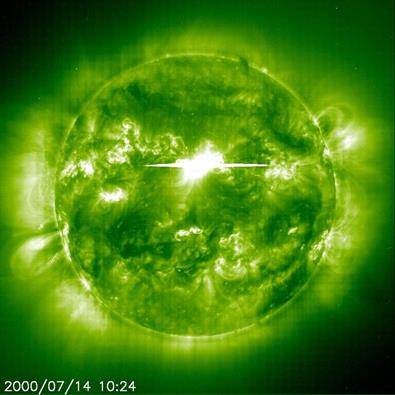
Review of solar activity
During the first part of the week, active region NOAA 2665 developed from Beta to Beta-Gamma magnetic configuration. Two other but small regions were visible: NOAA 2666 was numbered on 13 July, and NOAA 2667 on 15 July, while rotating over the western solar limb. The SDO images underneath show an annotated white light image on the left and an EUV image on the right at the time of the M2 flare.
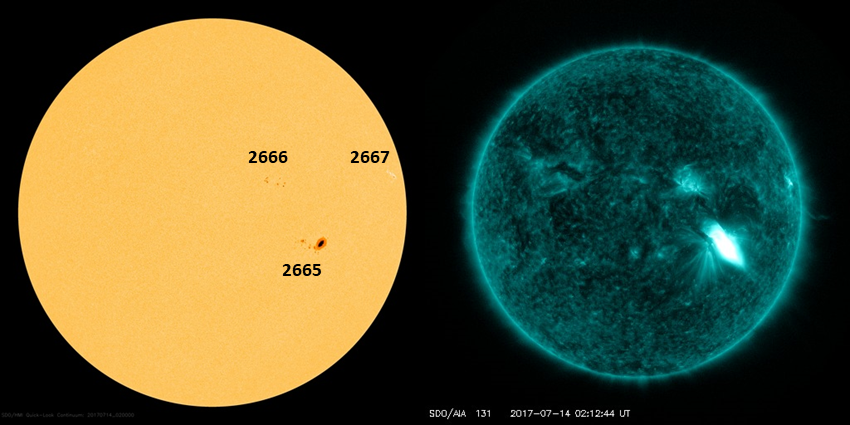
A period of elevated solar activity started on 13 July with NOAA 2667 producing multiple C flares and narrow coronal mass ejections (CMEs) mainly directed to the West. The most geo-effective event of the period was a full halo CME detected by CACtus on 14 July, visible in SoHO/LASCO C2 images from 01:36UT onwards. The CME was initiated by a long duration M2.4 class flare (START: 01:07UT; PEAK: 02:09UT END: 03:24UT) in NOAA 2665. The posterior analysis of the CME speed gave 1350 km/s (for 3D speed). Simultaneously the >10 MeV and >50 MeV proton fluxes at 1 AU started rising around 04UT, with the >10 MeV flux reaching its maximum of 22.4 pfu on 14 July at 23:20UT. The >10 MeV proton flux then gradually returned to near background levels by noon on 16 July.
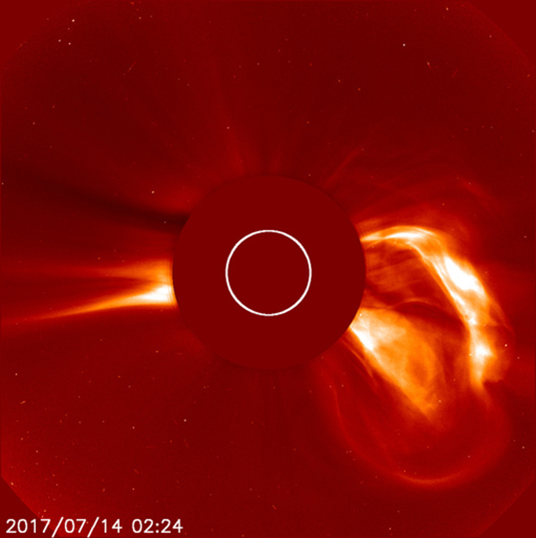
Noticeable Solar Events (10 Jul 2017 - 16 Jul 2017)
| DAY | BEGIN | MAX | END | LOC | XRAY | OP | 10CM | TYPE | Cat | NOAA |
| 14 | 0107 | 0209 | 0324 | S6W29 | M2.4 | 1N | 130 | IV/1 | 36 | 2665 |
| LOC: approximate heliographic location | TYPE: radio burst type |
| XRAY: X-ray flare class | Cat: Catania sunspot group number |
| OP: optical flare class | NOAA: NOAA active region number |
| 10CM: peak 10 cm radio flux |
PROBA2 Observations (10 Jul 2017 - 16 Jul 2017)
Solar Activity
Solar flare activity fluctuated between very low and moderate during the week.
In order to view the activity of this week in more detail, we suggest to go to the following website from which all the daily (normal and difference) movies can be accessed: http://proba2.oma.be/ssa
This page also lists the recorded flaring events.
A weekly overview movie can be found here (SWAP week 381):
http://proba2.oma.be/swap/data/mpg/movies/weekly_movies/weekly_movie_2017_07_10.mp4
Details about some of this week's events, can be found further below.
If any of the linked movies are unavailable they can be found in the P2SC movie repository here:
http://proba2.oma.be/swap/data/mpg/movies/
Thursday Jul 13
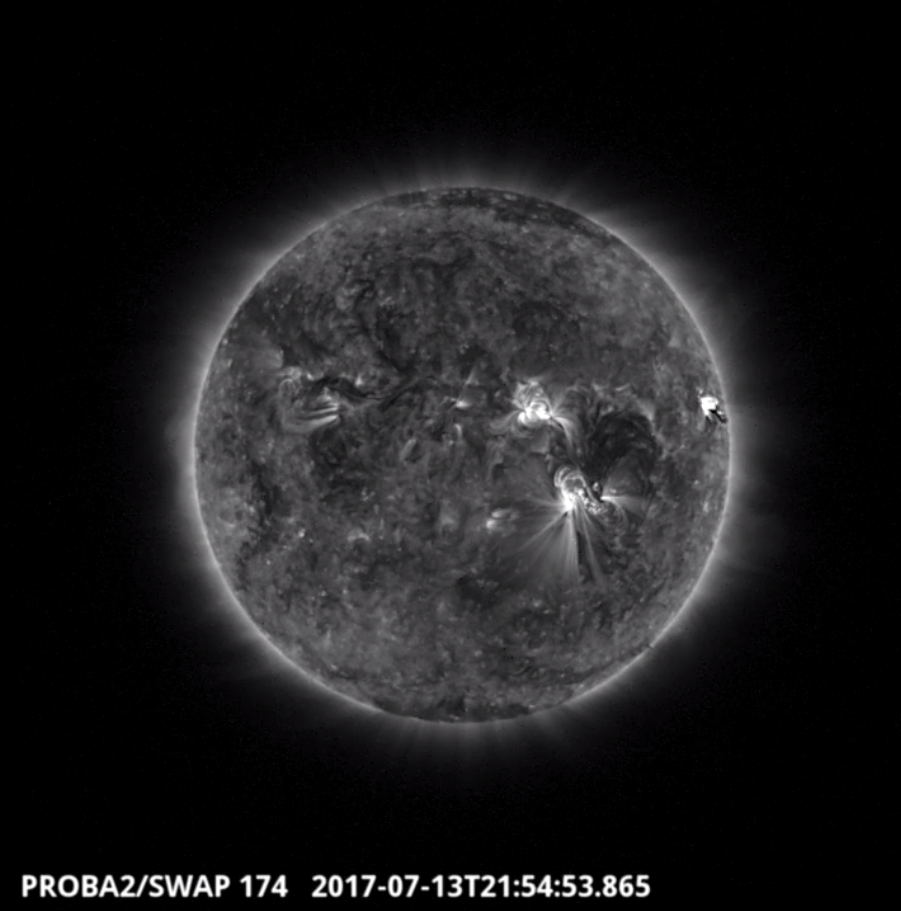
On 2017-Jul-13 multiple C-class flares and small eruptions were seen from NOAA AR 2667. One of which is shown in the SWAP image above at 21:54 UT, where the active region is situated near the west limb of the Sun.
Find a movie of the events here (SWAP movie):
http://proba2.oma.be/swap/data/mpg/movies/20170713_swap_movie.mp4
Friday Jul 14
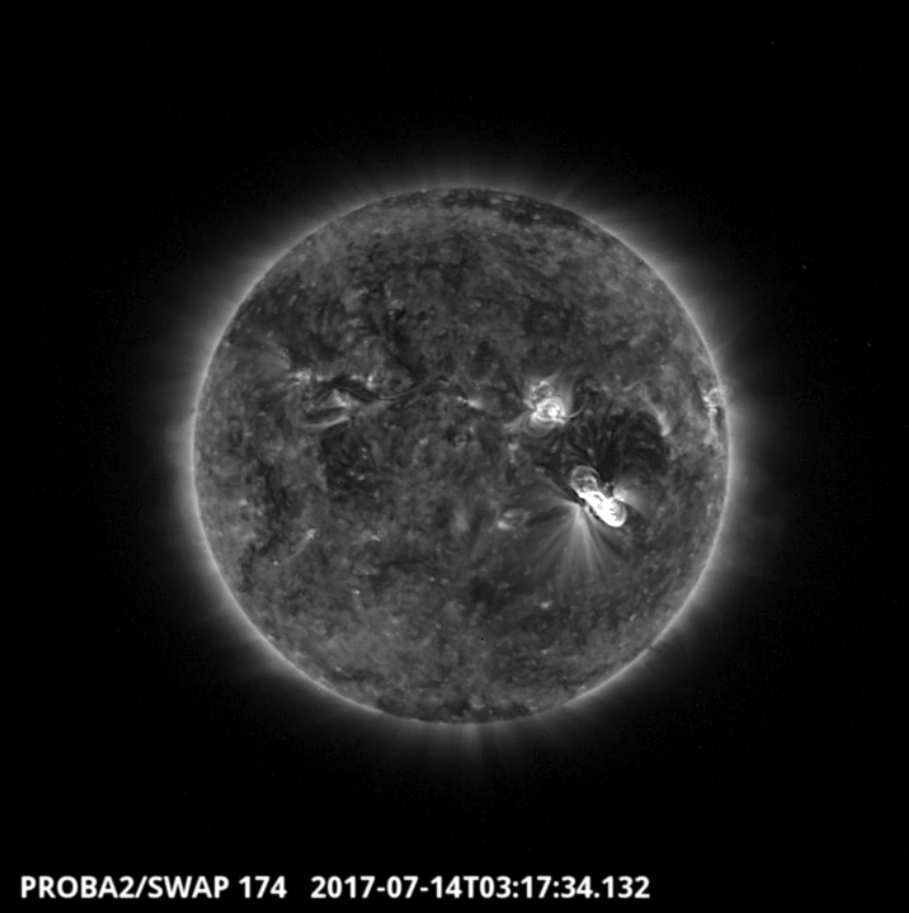
A long duration M-class flare (M2.4) was observed by SWAP on 2017-Jul-14. The flaring region (NOAA AR 2655) with bright coronal loops can be seen in the western hemisphere of the Sun at 03:17 UT in the SWAP image above.
Find a movie of the event here (SWAP movie):
http://proba2.oma.be/swap/data/mpg/movies/20170714_swap_movie.mp4
Saturday Jul 15
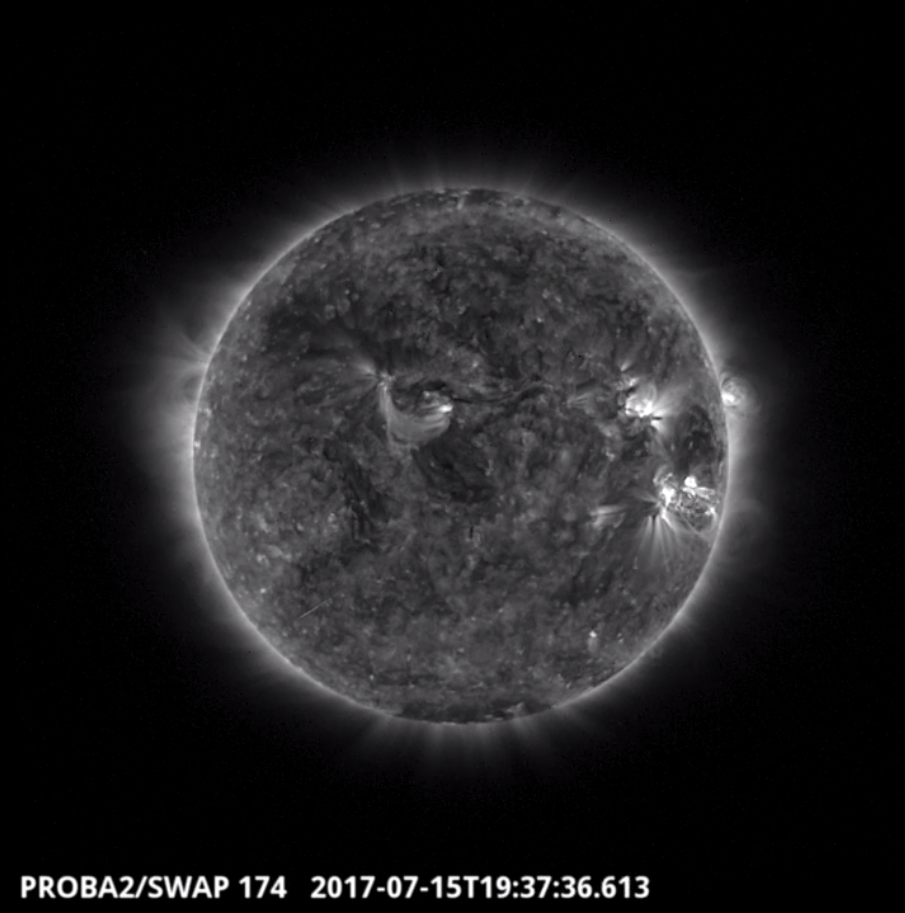
The same active region (NOAA AR 2655) continued to produce lower level flaring activity, including a C5.8 flare at 19:37 UT on 2017-Jul-15 shown in the SWAP image above.
Find a movie of the event here (SWAP movie):
http://proba2.oma.be/swap/data/mpg/movies/20170715_swap_movie.mp4
The International Sunspot Number
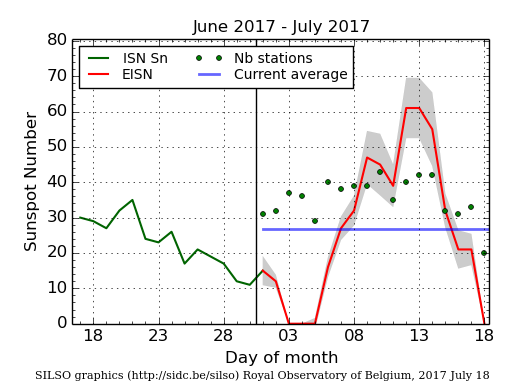
The daily Estimated International Sunspot Number (EISN, red curve with shaded error) derived by a simplified method from real-time data from the worldwide SILSO network. It extends the official Sunspot Number from the full processing of the preceding month (green line). The plot shows the last 30 days (about one solar rotation). The horizontal blue line shows the current monthly average, while the green dots give the number of stations included in the calculation of the EISN for each day.
Review of geomagnetic activity
Solar wind parameters were at background levels till approximately 05:15UT on 16 July when the Bastille Day halo coronal mass ejection (CME) arrived, detected by DSCOVR as a shock in the solar wind. Solar wind speed jumped from about 320 km/s to 505 km/s, and total magnetic field strength Bt from 3.5 to 28 nT (DSCOVR). The solar wind density increased by 10 times (50 particles per cm^3) and also a strong increase in temperature was observed. Bz variations increased first from -2/+2 nT to +7/-12 nT, then between 10:15 and 11:45UT, it was persistently at -23 nT. Solar wind speed reached a maximum of over 630 km/s around 21:00UT (16 July) before declining to 550 km/s by the end of the period.
Geomagnetic conditions were mostly at quiet to unsettled levels until the halo CME arrived. Minor (Kp = 5) and moderate (Kp = 6) magnetic storms occurred from 06 UT till the end of the same day (16th of July). Later Kp index returned to active conditions (Kp=4). The local K index at Dourbes was at active to minor storming levels (K= 4 to 5).
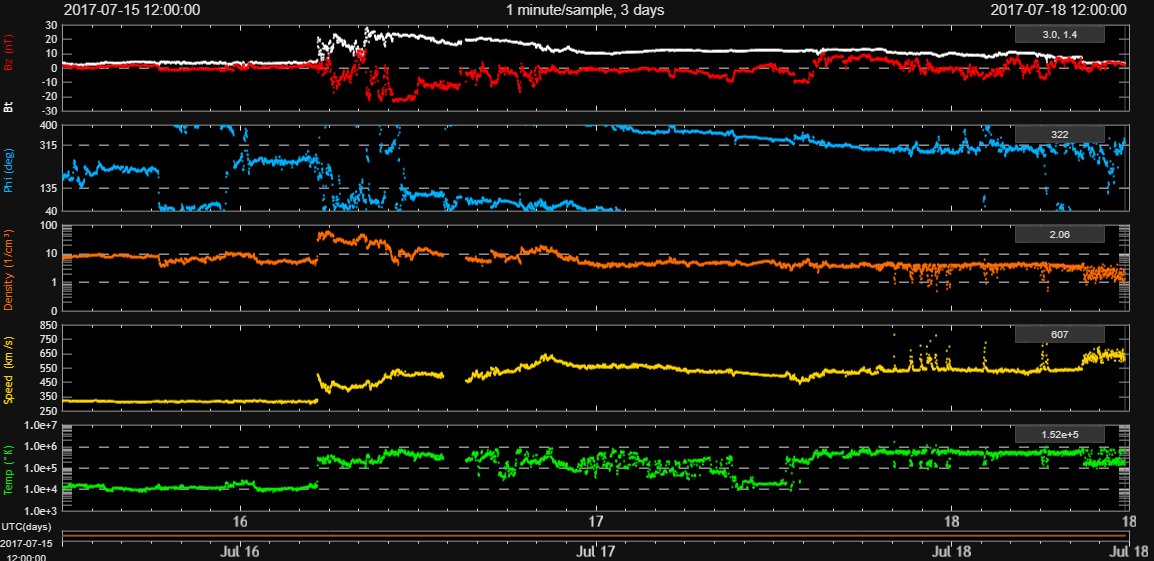
SIDC Space Weather Briefing
The Space Weather Briefing presented by the forecaster on duty from 10 July till 16 July. It reflects in images and graphs what is written in the Solar and Geomagnetic Activity reports. A .wmv version can be found at http://stce.be/movies/SIDCbriefing-2017Jul16.wmv
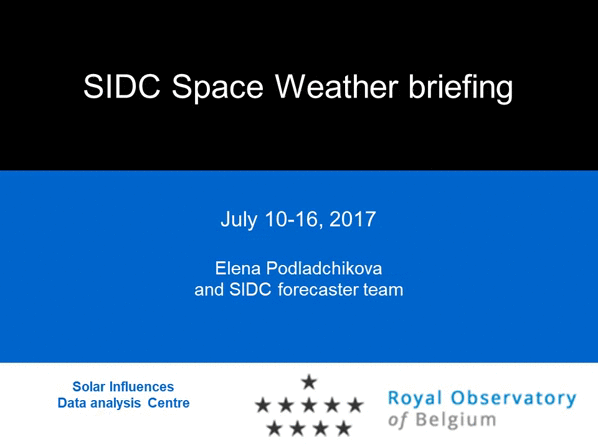
Review of ionospheric activity (10 Jul 2017 - 16 Jul 2017)
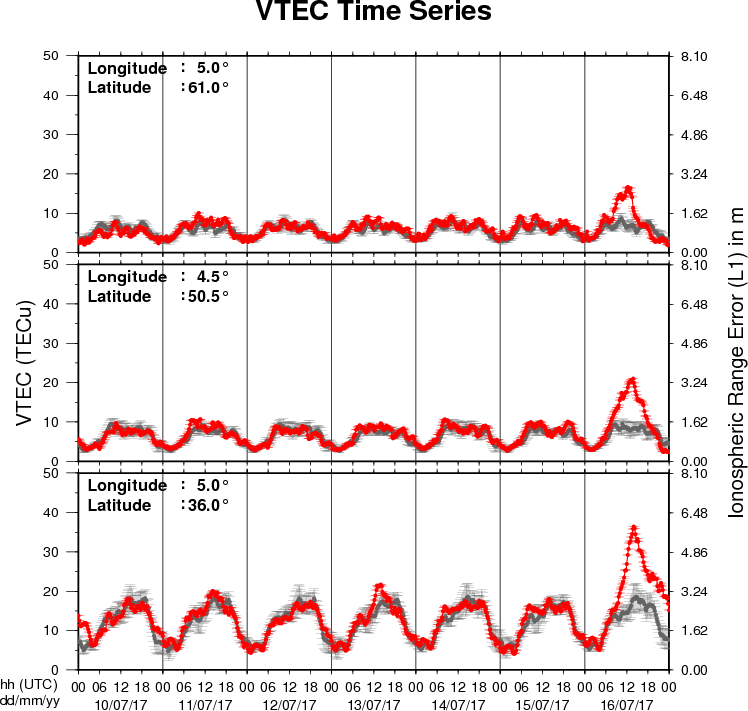
The figure shows the time evolution of the Vertical Total Electron Content (VTEC) (in red) during the last week at three locations:
a) in the northern part of Europe(N61°, 5°E)
b) above Brussels(N50.5°, 4.5°E)
c) in the southern part of Europe(N36°, 5°E)
This figure also shows (in grey) the normal ionospheric behaviour expected based on the median VTEC from the 15 previous days.
The VTEC is expressed in TECu (with TECu=10^16 electrons per square meter) and is directly related to the signal propagation delay due to the ionosphere (in figure: delay on GPS L1 frequency).
The Sun's radiation ionizes the Earth's upper atmosphere, the ionosphere, located from about 60km to 1000km above the Earth's surface.The ionization process in the ionosphere produces ions and free electrons. These electrons perturb the propagation of the GNSS (Global Navigation Satellite System) signals by inducing a so-called ionospheric delay.
See http://stce.be/newsletter/GNSS_final.pdf for some more explanations ; for detailed information, see http://gnss.be/ionosphere_tutorial.php
Future Events
For more details, see http://www.spaceweather.eu/en/event/future
United Nations/United States of America Workshop on the International Space Weather Initiative in Massachusetts (USA)
Start : 2017-07-31 - End : 2017-08-04
This workshop marks the 10th anniversary of the International
Heliophysical Year, which led to the genesis of the International
Space Weather Initiative. It is organized jointly by the Office for
Outer Space Affairs, the National Aeronautics and Space
Administration (NASA) and Boston College to highlight the
achievements made over the past ten years and to show-case the
worldwide development of science, capacity building, and
outreach.
The UN Workshops on ISWI have been aimed at providing a global
forum for space weather experts from developed and developing
countries, including representatives of the major instrument
operators and data providers. In particular the Workshop will focus
on recent advances made in scientific research by utilizing ISWI
instrument data in conjunction with space mission data in adding
significant new knowledge on space weather phenomena near Earth and
interplanetary space.
The workshop will begin with a high level international forum on
the economic and societal effects of extreme space weather. This
forum will include keynote speakers from major international
organizations followed by a panel session to discuss issues and
policies for acknowledging space weather as a global challenge.
The workshop is also held in preparation for UNISPACE+50 in
2018, the 50th anniversary of the first UN Conference on the
Exploration and Peaceful Uses of Outer Space (UNISPACE), held in
Vienna in 1968. The three components of the Workshop will also help
develop a coherent international policy towards an appropriate
response to space weather.
Website: https://iswi2017.bc.edu/
URSI General Assembly in Montreal, Canada
Start : 2017-08-19 - End : 2017-08-26
For the thirty-second time since the inception of URSI, Radio
Scientists from across the world will get together for the URSI
General Assembly and Scientific Symposium. This triennial gathering
will take place from 19th to 26th of August 2017, in Montreal,
Canada. This conference is a unique opportunity to learn about
recent advances in all fields of Radio Science, as covered by all
ten URSI Commissions.
Among the different sessions, please note:
* 'Radio Science for Space Weather'
Conveners: M. Messerotti, V. Pierrard
* 'Remote Sensing and Modeling of the Earth's Plasmasphere
and Plasmapause'
Conveners: A. M. Jorgensen, V. Pierrard, B. Heilig
The abstract deadline is 30 January 2017
Website: http://www.ursi2017.org
2017 Joint IAPSO-IAMAS-IAGA Assembly in Cape Town, South Africa
Start : 2017-08-27 - End : 2017-09-01
The Joint IAPSO-IAMAS-IAGA Assembly, endorsed by the University
of Cape Town and the South African Department of Science and
Technology, will take place from 27 August to 1 September 2017 at
the Cape Town International Convention Centre (CTICC). Several IAGA
and IAMAS sessions are of Space Weather interests as well as the
joint session 'Space Weather throughout the Solar System: Bringing
Data and Models together'.
Website:
http://iapso-iamas-iaga2017.com/index.php
Workshops on Radiation Monitoring for the International Space Station in Torino, Italy
Start : 2017-09-05 - End : 2017-09-07
The Workshop on Radiation Monitoring for the International Space
Station is an annual meeting to discuss the scientific definition
of an adequate radiation monitoring package and its use by the
scientific community on the ISS. Types of instruments and research
topics need to be defined in order to optimise the radiation safety
of the ISS crew.
Website: http://wrmiss.org/
International Workshop on Solar, Heliospheric & Magnetospheric Radioastronomy in Meudon, France
Start : 2017-11-06 - End : 2017-11-10
Jean-Louis Steinbeg has been one of the major pioneers in
radioastronomy. Co-founder of the Nançay Observatory, he
has actively participated to, an inspired a large number of radio
instruments on many international space missions. Jean-Louis
Steinberg is the founder of the Space Radioastronomy laboratory of
the Paris Observatory in 1963. Later on, this laboratory widened
its science interests and became the DESPA (1971) and then the
current LESIA (2002) which is one of the major space sciences
laboratories in France. The aim of this workshop is to cover the
science topics which Jean-Louis Steinberg has promoted during his
career, focusing on Solar, Heliospheric & Magnetospheric
radioastronomy & physics. This will be done by covering both
observations from either ground facilities (NDA, RH, LOFAR, Artemis
etc ...) or space missions (ISSEE, Ulysses, WIND, CLUSTER, STEREO,
CASSINI, JUNO etc ...) and models/theories. A series of invited
talks is also foreseen to cover the new developments in the
discipline which may come with the future facilities such as Solar
Orbiter, Solar Probe Plus, JUICE, JUNO, LOFAR+, SKA etc ....
This workshop will also be the opportunity to remember both the
extraordinary personal & professional lifes of Jean-Louis
Steinberg especially for new generation of scientists. At the
occasion of this workshop it is also expected that the Building 16
(historical Space Sciences building) on the Meudon campus will be
renamed "Building Jean-Louis Steinberg".
Website:
https://jlsworkshop.sciencesconf.org/
European Space Weather Week 14
Start : 2017-11-27 - End : 2017-12-01
The ESWW is the main annual event in the European Space Weather
calendar. It is the European forum for Space Weather as proven by
the high attendance to the past editions. The agenda will be
composed of plenary/parallel sessions, working meetings and
dedicated events for service end-users. The ESWW will again adopt
the central aim of bringing together the diverse groups in Europe
working on different aspects of Space Weather.
Website:
http://www.stce.be/esww14/
